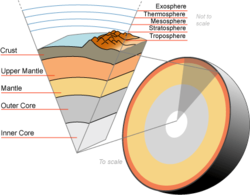Earth's mantle - Simple English Wikipedia, the free encyclopedia
The Earth's mantle has two layers. There is a rigid upper layer and a softer layer. It is between the Earth's crust and the Earth's outer core.[1][2]
The upper mantle
[change | change source]
Past episodes of melting and volcanism at the outer levels of the mantle have produced a very thin crust of crystallized melt products near the surface, where we live. The gases evolved during the melting of Earth's mantle have a large effect on the composition and size of Earth's atmosphere.
Uppermost mantle
[change | change source]The top of the mantle is the Moho at the base of the crust. The base of the crust varies from about 10 to 70 kilometers deep. Oceanic crust is generally less than 10 kilometers thick. "Standard" continental crust is around 35 kilometers thick, and the large crustal root under the Tibetan Plateau is about 70 kilometers thick.
A thin crust, the lower part of the lithosphere, surrounds the mantle and is about 5 to 75 km thick.[3] There are two main zones in the upper mantle. The uppermost mantle plus overlying crust are relatively rigid and form the lithosphere, an irregular layer with a maximum thickness of perhaps 200 km, of which the uppermost mantle is 120 to 50 km thick.[4]
Asthenosphere
[change | change source]Below the lithosphere the upper mantle becomes notably more plastic. It is called the asthenosphere, and is composed of flowing rock in the state of plasticity, about 200 km thick.[5]
Lower mantle
[change | change source]The lower mantle is much thicker than the upper mantle. It is made of magma, under great pressure, and so is thicker (higher viscosity) and flows less easily. The lower mantles temperature has a max of about 4,000 °C (7,000 °F).
The chemical composition of the mantle is heavily biased towards three elements: oxygen 44.8% by weight; magnesium 22.8%; silicon 21.5%. Compounds are oxides: silica SiO2 46%; magnesium oxide MgO 37.8%.
Place with no crust
[change | change source]In 2007 a team of scientists on board the RRS James Cook went to an area of the Atlantic seafloor where the mantle has no crust covering. The anomaly is mid-way between the Cape Verde Islands and the Caribbean in the Atlantic Ocean, at or near the Mid-Atlantic Ridge. It is about three kilometres under the ocean surface and covers thousands of square kilometres.[6][7]
Other such 'Oceanic Core Complexes' (OCCs) were found later.[8] Many have active hydrothermal vents.
References
[change | change source]- ↑ Robertson, Eugene (2007). "The interior of the earth". USGS. Retrieved 2009-01-06.
- ↑ Lodders, Katharina (1998). The planetary scientist's companion. Fegley, Bruce. New York: Oxford University Press. ISBN 1-4237-5983-4. OCLC 65171709.
- ↑ "Crust: Schlumberger Oilfield Glossary". Archived from the original on 2012-05-31. Retrieved 2011-01-12.
- ↑ "Lithosphere: Schlumberger Oilfield Glossary". Archived from the original on 2012-06-03. Retrieved 2011-01-12.
- ↑ "Asthenosphere: Schlumberger Oilfield Glossary". Archived from the original on 2012-05-30. Retrieved 2011-01-12.
- ↑ "Distance and location". www.msnbc.msn.com. Archived from the original on 2008-05-11. Retrieved 2008-06-19.
- ↑ "About the Mantle". www.sciencedaily.com. Retrieved 2008-06-19.
- ↑ "Roger Searle 2009. Planet Earth online". Archived from the original on 2010-11-21. Retrieved 2011-01-15.
Other websites
[change | change source]- Information on the Mohole Project Archived 2015-11-02 at the Wayback Machine


 French
French Deutsch
Deutsch